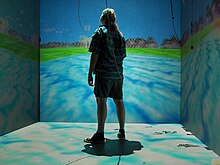Cyberdelic
| Part of a series on |
| Psychedelia |
|---|

Cyberdelic (from "
Cyberdelic art was created by calculating fractal objects and representing the results as still images, animations, underground, algorithmic music, or other media.
Cyberdelic rave dance parties featured psychedelic trance music alongside laser light shows, projected images, and artificial fog, while attendees often used club drugs.
Advocates
In contrast to some of the hippies of the 1960s who were
In 1992,
Collapse
After the
Disillusioned, R. U. Sirius condemned cyberdelic escapism:
[...] Anybody who doesn't believe that we're trapped hasn't taken a good look around. We're trapped in a sort of mutating multinational corporate oligarchy that's not about to go away. We're trapped by the limitations of our species. We're trapped in time. At the same time identity, politics, and ethics have long turned liquid. [...] Cyberculture (a meme that I'm at least partly responsible for generating, incidentally) has emerged as a gleeful apologist for this kill-the-poor trajectory of the Republican revolution. You find it all over Wired ["the Rolling Stone of technology"] - this mix of chaos theory and biological modeling that is somehow interpreted as scientific proof of the need to devolve and decentralize the social welfare state while also deregulating and empowering the powerful, autocratic, multinational corporations. You've basically got the breakdown of nation states into global economies simultaneously with the atomization of individuals or their balkanization into disconnected sub-groups, because digital technology conflates space while decentralizing communication and attention. The result is a clear playing field for a mutating corporate oligarchy, which is what we have. I mean, people think it's really liberating because the old industrial ruling class has been liquefied and it's possible for young players to amass extraordinary instant dynasties. But it's savage and inhuman. Maybe the wired elite think that's hip. But then don't go around crying about crime in the streets or pretending to be concerned with ethics.[2]
See also
- Algorave
- Cybergoth
- Demoscene
- Fractal art
- Immersive technology
- Postcyberpunk
- Virtual world
References
- ISBN 0-914171-77-1.
- ^ a b c d Ruthofer, Arno (1997). "Think for Yourself; Question Authority". Archived from the original on 2007-11-12. Retrieved 2007-02-02.
{{cite journal}}: Cite journal requires|journal=(help) - ^ Gourley, Bob (1993). "Billy Idol". Chaos Control Digizine. Bob Gourley. Archived from the original on 2007-10-09. Retrieved 2008-08-12.
- ^ Saunders, Michael (1993-05-19). "Billy Idol turns 'Cyberpunk' on new CD". The Boston Globe. 135 Morrissey Boulevard. Boston, Massachusetts, United States: P. Steven Ainsley. Archived from the original on 2009-02-16. Retrieved 2008-08-12.
{{cite news}}: CS1 maint: location (link) - Village Voice. Retrieved 2007-11-11.
- ^ alt.cyberpunk: Frequently Asked Questions. project.cyberpunk.ru (2004)
- ^ Branwyn, Gareth (1998). "Idol 'ware". Beyond Cyberpunk!. The Computer Lab. Retrieved 2008-08-12.
- ^ Jillette, Penn (December 1993). "Billy Idol - Learning to Type". PC/Computing. 6 (12): 506. Archived from the original on 2003-03-26. Retrieved 2008-08-12.
Further reading
- Foster, Thomas (2005-05-01). The Souls of Cyberfolk: Posthumanism as Vernacular Theory. Electronic Mediations Series. Vol. 13 (First ed.). ISBN 0-8166-3406-8.
- Mondo 2000: A User's Guide to the New Edge Rudy Rucker, R.U. Sirius, Queen Mu (ISBN 0-06-096928-8)
External links
- "Beyond Cyberpunk!:The Web Version", by Gareth Branwyn. (ca 1991) An online version of the original HyperCard stack about cyberdelic culture. Was updated in '93 with new material.
- Media
- "Tim Leary and the Cyberpunks", Allan Lundell, YouTube, February 11, 2009. Timothy Leary describes the cyberdelic/cyberpunk movement in context of the Cyberpunk album, by Billy Idol.
- "Timothy Leary Interviews Billy Idol - In Concert with The Ramones" (1993), an interview discussing the cyberpunk counterculture for the ABC television show, In Concert, hosted by the Internet Archive.
- "Lecture for the Whole Life Expo in Los Angeles" (November 1989), a Timothy Leary lecture on connections between psychedelic and cybernetic cultures, hosted by the Internet Archive.
